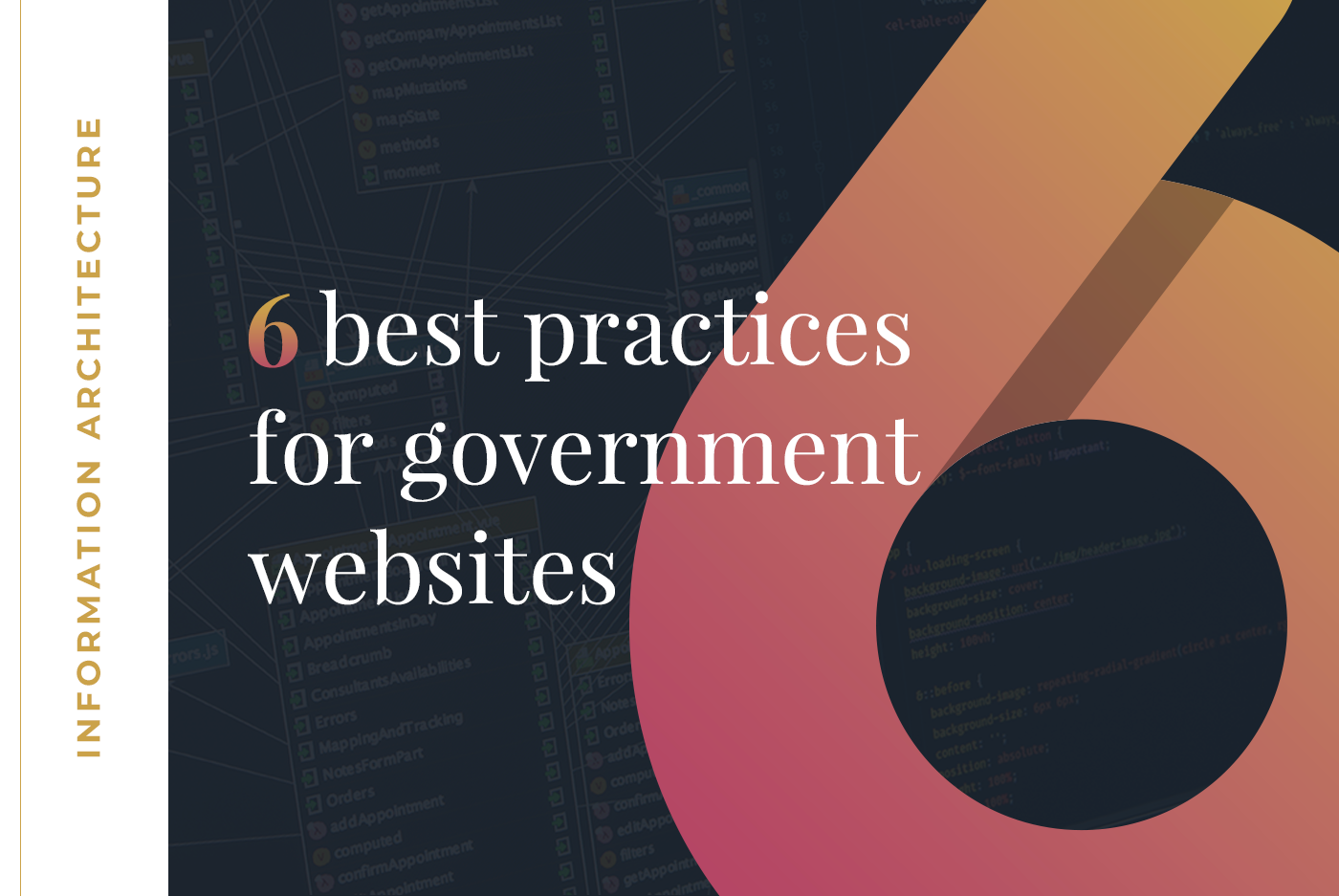When 21st Century IDEA became law in 2018, federal agencies faced a mandate to modernize their websites. IDEA sets out baseline requirements to ensure that these efforts deliver better digital experiences for government stakeholders, including citizens.
In addition to things like accessibility and security, IDEA calls for agency websites to be user-centered and searchable, and to avoid duplication with legacy websites.
One key to meeting these criteria is a sound information architecture.
What is information architecture?
Information architecture (IA) is the science of organizing information to create clear paths to content – aka user journeys.
Often mistaken as a synonym for navigation, IA underpins everything users do to find what they need. This includes navigation, for sure. It also includes on-site and public search, filtering and sorting, and skimming and scanning.
What’s different about IA for government agencies?
The internet is rife with IA advice for ecommerce, B2B, and other sites designed around a classic buyer’s journey. And while some of that advice applies to government, much of it falls short.
Some agency sites do support fee-for-service transactions, and some even sell branded merch, but no government site is pure ecommerce. Most are structured to support information journeys, behavior change journeys, compliance journeys, journeys related to policy and process transparency – and sometimes all the above.
To help agencies hit the 21st Century IDEA mark, here are six best practices to help define an IA that supports government user journeys:
1. Publish your org chart, but don’t use it to structure content
Organizational structures exist for good reason. And it’s often tempting – really tempting – to organize a website along these lines. It simplifies decision approval, content reviews, and even project funding.
In our experience, the org chart-based site map is one of the most common pitfalls plaguing government websites.
The chief problem is that citizens and regulated communities neither know nor care which department runs which program. What’s more, an org chart-centric site is only good until the next re-org or the creation of a new program.
By letting audience needs drive IA decisions, you’re one giant step closer to an IDEA-friendly, user-centered digital experience.
As a bonus, the process of developing a user-centric IA can foster intra-agency collaboration and positive culture change.
2. Find a best-fit home for each page
Committing to a user-centered IA means organizing information based on audience expectations and preferences. But an agency website serves many audiences – arguably far more than corporate or large nonprofit websites.
Depending on your mission, site visitors could be individual citizens, businesses, media or watchdog groups, legislators, teachers and students, researchers, advocacy organizations, job seekers, or others – each with their own, discrete needs.
It may seem like a good idea to duplicate content under different categories or sections to optimize for findability, but that runs counter to a key requirement under IDEA. And it works against you in other ways, too. Duplicate content confuses site visitors and multiplies your maintenance burden. It also degrades SEO, as many search engines see duplicative content as spammy.
To create an effective IA, you will have to make some tough choices. Accept that there is no perfect site map, pick a best-fit home for each page, and look to analytics and A/B testing to make data-driven adjustments over time.
Note: A well-defined taxonomy also helps users find what they need.
3. Enable audiences to self-segment
For some of your content, the audience will be well defined. For example, press releases and your media kit are for journalists, careers and culture information are for job seekers, and funding opportunities are for government contractors.
By carving out these discrete content collections in your IA, you can tailor key user journeys to support an audience’s most frequent or important goals. And you can implement effective design solutions that present site visitors with a clear path based on who they are.
Building audience segmentation into your site structure also enables analytics to capture a clear picture of who is – and isn’t – using your site to effect.
4. Don’t overwhelm the user
Given their many audiences and stakeholders, many agency websites have a LOT of content to wrangle. Programs, initiatives, policy and regulations, research priorities, citizen services, outreach events, etc.
Each is important to someone within the agency, and every department and program wants equal billing. For many an agency website, this results in long drop-down menus and competing calls to action (CTAs).
The problem? Having too many choices creates cognitive overload and can paralyze the user.
A common guideline is to limit menus and lists to no more than 7 items, and to select a single primary CTA for each page.
Fortunately, modern design and development solutions – like expandable modules and incremental content loading – can do a lot to offset that cognitive burden while still representing the full breadth of an agency’s information.
A robust taxonomy also allows users to winnow down choices by filtering according to topic, content type, date, etc.
5. Don’t publish FAQs
Google “government FAQ” and you will find that agencies love to collect and share frequently asked questions.
Unfortunately, this approach is not a great way to help users find what they need.
The typical FAQ page is a long-scroll experience. It often duplicates information contained elsewhere. And it’s usually made up of questions your experts think people should be asking, not what your constituents actually want to know. If your site visitors are leaning heavily on the FAQ page, it’s generally a good sign that your IA isn’t working.
Don’t just take our word for it. The GSA’s in-house digital consulting team agrees.
FAQs do have some value, though! So before you delete it wholesale, analyze traffic, clicks, scroll depth, and other analytics. This behavioral data may offer insights to help fix underlying IA issues.
6. Bring microsites into the fold
Often launched as short-term solutions (particularly for underfunded mandates), microsites tend to become long-term problems.
A common source of the duplicative content that IDEA seeks to avoid, microsites can confuse users and distribute your SEO “juice” across what search engines see as separate domains.
They also represent a maintenance challenge. When the program or initiative that drove the microsite effort runs out of funding, it falls into a state of “content rot.”
Your agency’s digital transformation initiative presents an ideal opportunity to unify content on a single site. And any time leadership suggests a microsite, the underlying organizational or policy driver can inform a business case for a more comprehensive project.
The power of user-centered information architecture
Designing IA begins by thinking about your audience and then thinking like your audience. Who are they? What do they need? And where would they expect to find it?
These best practices can help agencies align on key requirements under 21st Century IDEA, avoid common pitfalls, and deliver truly intuitive user journeys. Not only does that help optimize the government customer experience, it can galvanize pride and excitement internally and support the case for continued or expanded funding for agency programs.
At Spire, we are staunch advocates for – and occasionally giddy fans of – government innovation and everything federal agencies do in service of the public interest. Ditto for the principles of 21st Century IDEA. We work closely with clients to define the information architecture that best supports their website goals and objectives—so that every user journey ends where the user wanted to go.
Want to know more? Check out our website services.
Next up, we’ll explore how your IA—and the resulting site map—can double as a project management tool, defining the overall scope, tracking progress, and aligning design, development, and content workstreams.









